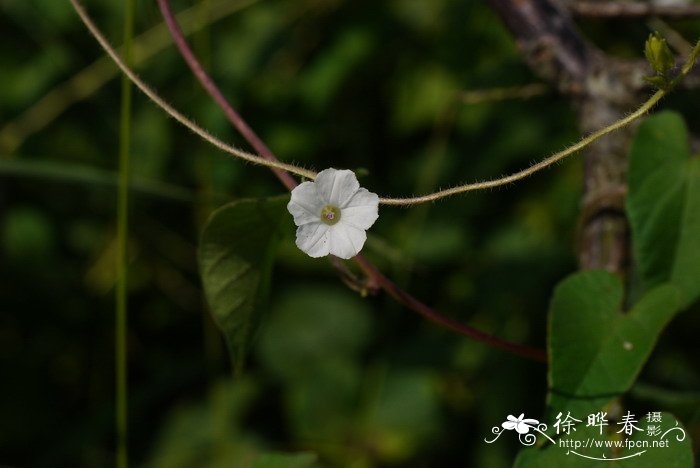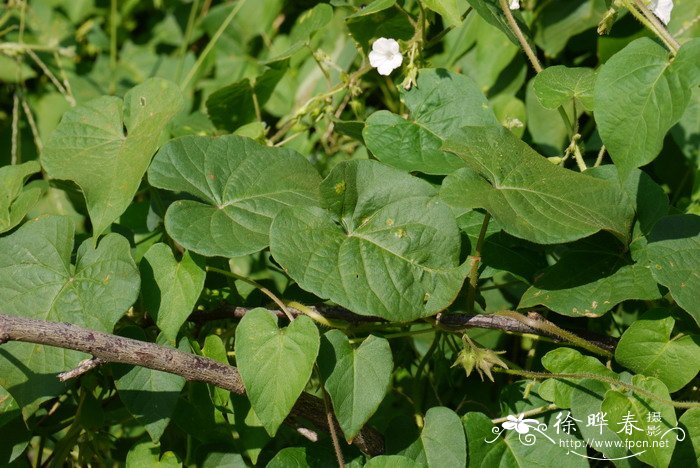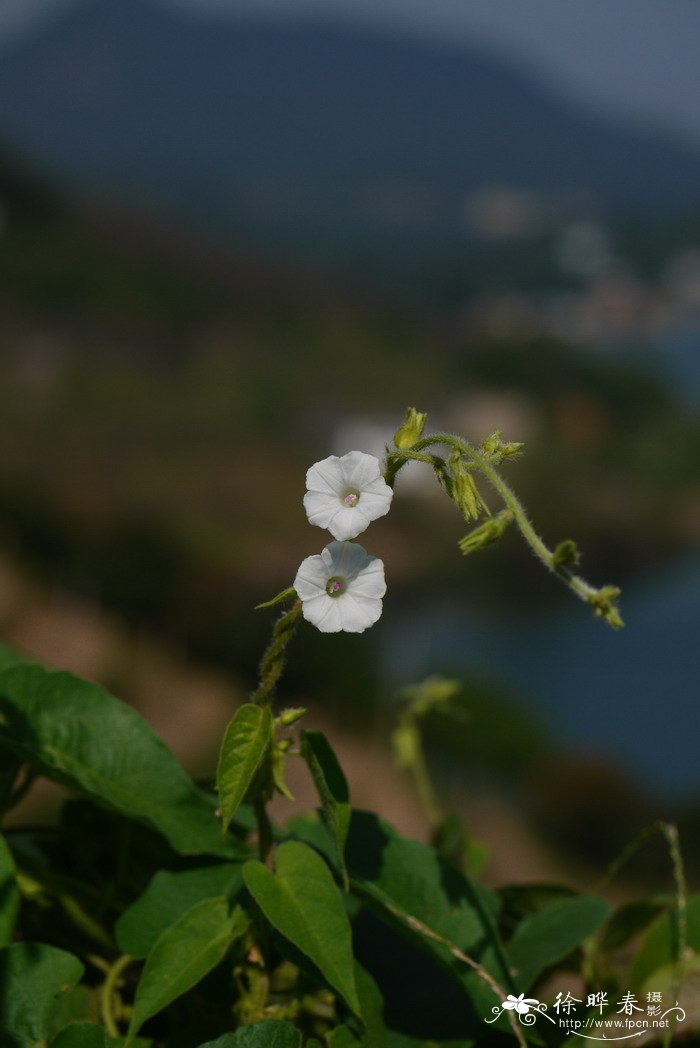毛牵牛Ipomoea biflora
中文名(Chinese Name):毛牵牛
学名(Scientific Name):Ipomoea biflora (L.) Pers.
英文名(English Common Name):
别名(Chinese Common Name):满山香、黑面藤、亚灯堂、华陀花
异名(Synonym):Convolvulus plebeius (R. Br.) Spreng. Aniseia biflora (Linn.) Choisy Aniseia calycina (Roxb.) Choisy Convolvulus sinensis Desr. Convolvulus biflorus L. Convolvulus ser Spreng. Convolvulus hardwickii Spreng. Ipomoea timorensis Blume Ipomoea hardwickii (Spreng.) Hemsl. Ipomoea calycina (Roxb.) Benth. ex C. B. Clarke Ipomoea sinensis (Desr.) Choisy Ipomoea plebeia R. Br.
科属(Family & Genus):旋花科Convolvulaceae番薯属Ipomoea
形态特征(Description):攀援或缠绕草本;茎细长,径约1.5-4毫米,有细棱,被灰白色倒向硬毛。叶心形或心状三角形,长4-9.5厘米,宽3-7厘米,顶端渐尖,基部心形,全缘或很少为不明显的3裂,两面被长硬毛,侧脉6-7对,在两面稍突起,第三次脉近于平行,细弱;叶柄长1.5-8厘米,毛被同茎。花序腋生,短于叶柄,花序梗长3-15毫米,或有时更短则花梗近于簇生,毛被同叶柄,通常着生2朵花,有时1或3;苞片小,线状披针形,被疏长硬毛;花梗纤细,长8-15毫米,毛被同叶柄;萼片5,外萼片三角状披针形,长8-10毫米,宽4-5毫米,基部耳形,外面被灰白色疏长硬毛,具缘毛,内面近于无毛,在内的2萼片线状披针形,与外萼片近等长或稍长,萼片于结果时稍增大;花冠白色,狭钟状,长1.2-1.5(-1.9)厘米,冠檐浅裂,裂片圆;瓣中带被短柔毛;雄蕊5,内藏,长3毫米,花丝向基部渐扩大,花药卵状三角形,基部箭形;子房圆锥状,无毛,花柱棒状,长3毫米,柱头头状,2浅裂。蒴果近球形,径约9毫米,果瓣内面光亮。种子4,卵状三棱形,高4毫米,毛被不尽相同,被微毛或被短绒毛,沿两边有时被白色长绵毛。
分布(Distribution):产我国台湾、福建、江西、湖南、广东及其沿海岛屿、广西、贵州、云南等省区。生于海拔150-1800米的山坡、山谷、路旁或林下,常见于较干燥处。越南也有。
用途(Use):广西民间用茎、叶治小儿疳积,种子治跌打、蛇伤。
引自中国植物志英文版:FOC Vol. 16 Page 304
Ipomoea biflora (Linnaeus) Persoon, Syn. Pl. 1: 183. 1805.
毛牵牛 mao qian niu Login | eFloras Home | Help
Convolvulus biflorus Linnaeus, Sp. Pl. ed. 2., App. 1668. 1763; Aniseia biflora (Linnaeus) Choisy; A. calycina (Roxburgh) Choisy; C. calycinus Roxburgh; C. hardwickii Sprengel; C. plebeius (R. Brown) Sprengel; C. ser Sprengel; C. sinensis Desrousseaux; Ipomoea calycina (Roxburgh) Bentham ex C. B. Clarke; I. cynanchifolia C. B. Clarke, p.p.; I. hardwickii (Sprengel) Hemsley; I. plebeia R. Brown; I. sinensis (Desrousseaux) Choisy; I. timorensis Blume.
Herbs annual, scandent or twining, with ± grayish hirsute axial parts. Stems 1-2 m. Petiole 1.5-8 cm; leaf blade cordate or deltate-cordate, 4-9.5 3-7 cm, hirsute-villous, base cordate, margin entire, rarely slightly 3-lobed, apex acuminate; lateral veins 6 or 7 pairs. Inflorescences 1-3-flowered; peduncle (0-)3-15 mm; outer 3 bracts linear-lanceolate, small. Pedicel 0.8-1.5 cm. Sepals slightly enlarged in fruit; outer 3 deltate-lanceolate, 8-10 4-5 mm, abaxially grayish hirsute-villous, ciliate, adaxially subglabrous, base auriculate; inner 2 linear-lanceolate, ca. as long as or longer than outer 3. Corolla white, narrowly campanulate, 1.2-1.9 cm; limb shallowly lobed, midpetaline bands pubescent. Stamens ca. 3 mm; anthers ovoid-deltoid, base sagittate. Ovary conical, glabrous. Capsule ± globose, ca. 9 mm in diam., glabrous. Seeds ovoid-trigonous, ca. 4 mm, puberulent to tomentellous, margin sometimes white woolly.
Valleys, mountain slopes, roadsides, forests, usually in dry places; 200-1800 m. Fujian, Guangdong, Guangxi, Guizhou, Hunan, Jiangxi, Taiwan, Yunnan [India, Indonesia, Japan (Ryukyu Islands), ?Myanmar, Vietnam; E Africa, N Australia]
The taxonomy of the cordatesepalled, smallflowered ipomoeas in China needs further study. The Fl. Reipubl. Popularis Sin. account differs from other twentieth century floras in recognizing one, Aniseia biflora, instead of two species. The Chinese taxon has pantoporate, spinulose pollen grains, however, which indicates that it is a species of Ipomoea. The five known neotropical species of Aniseia all have nonspinulose, colpate pollen grains. The two issues not resolved in this account are whether one or two species should be recognized in China, and what names are to be applied to them.
Twentieth century floras for Africa, Asia, and Malesia recognize two species of smallflowered Ipomoea with cordate sepals: I. plebeia and I. sinensis. Several authors have pointed out that the original description of the Linnaean Convolvulus biflorus is ambiguous, and in the absence of any type specimen (at the herbaria LINN or S), they have reduced C. biflorus to the synonymy of Robert Brown's clearly defined and typified I. plebeia. Chinese specimens called I. (or Aniseia) biflora come very near to what has been called I. plebeia in contemporary African and Malesian floras.
Ipomoea sinensis, which occurs through much of the Old World tropics, is distinguished primarily by having peduncles to 4.5 cm long. The Fl. Reipubl. Popularis Sin. placed it in synonymy of Aniseia biflora. For the time being, the epithet biflora, which is well established in the Chinese literature, is here maintained to a single highly variable taxon defined much as in the Fl. Reipubl. Popularis Sin. A careful study of the entire complex of cordate-sepalled Ipomoea needs to be undertaken, however, to sort out the identities and nomenclature for the taxa involved.
The whole plant has several medicinal uses.



(责任编辑:徐晔春)
学名(Scientific Name):Ipomoea biflora (L.) Pers.
英文名(English Common Name):
别名(Chinese Common Name):满山香、黑面藤、亚灯堂、华陀花
异名(Synonym):Convolvulus plebeius (R. Br.) Spreng. Aniseia biflora (Linn.) Choisy Aniseia calycina (Roxb.) Choisy Convolvulus sinensis Desr. Convolvulus biflorus L. Convolvulus ser Spreng. Convolvulus hardwickii Spreng. Ipomoea timorensis Blume Ipomoea hardwickii (Spreng.) Hemsl. Ipomoea calycina (Roxb.) Benth. ex C. B. Clarke Ipomoea sinensis (Desr.) Choisy Ipomoea plebeia R. Br.
科属(Family & Genus):旋花科Convolvulaceae番薯属Ipomoea
形态特征(Description):攀援或缠绕草本;茎细长,径约1.5-4毫米,有细棱,被灰白色倒向硬毛。叶心形或心状三角形,长4-9.5厘米,宽3-7厘米,顶端渐尖,基部心形,全缘或很少为不明显的3裂,两面被长硬毛,侧脉6-7对,在两面稍突起,第三次脉近于平行,细弱;叶柄长1.5-8厘米,毛被同茎。花序腋生,短于叶柄,花序梗长3-15毫米,或有时更短则花梗近于簇生,毛被同叶柄,通常着生2朵花,有时1或3;苞片小,线状披针形,被疏长硬毛;花梗纤细,长8-15毫米,毛被同叶柄;萼片5,外萼片三角状披针形,长8-10毫米,宽4-5毫米,基部耳形,外面被灰白色疏长硬毛,具缘毛,内面近于无毛,在内的2萼片线状披针形,与外萼片近等长或稍长,萼片于结果时稍增大;花冠白色,狭钟状,长1.2-1.5(-1.9)厘米,冠檐浅裂,裂片圆;瓣中带被短柔毛;雄蕊5,内藏,长3毫米,花丝向基部渐扩大,花药卵状三角形,基部箭形;子房圆锥状,无毛,花柱棒状,长3毫米,柱头头状,2浅裂。蒴果近球形,径约9毫米,果瓣内面光亮。种子4,卵状三棱形,高4毫米,毛被不尽相同,被微毛或被短绒毛,沿两边有时被白色长绵毛。
分布(Distribution):产我国台湾、福建、江西、湖南、广东及其沿海岛屿、广西、贵州、云南等省区。生于海拔150-1800米的山坡、山谷、路旁或林下,常见于较干燥处。越南也有。
用途(Use):广西民间用茎、叶治小儿疳积,种子治跌打、蛇伤。
引自中国植物志英文版:FOC Vol. 16 Page 304
Ipomoea biflora (Linnaeus) Persoon, Syn. Pl. 1: 183. 1805.
毛牵牛 mao qian niu Login | eFloras Home | Help
Convolvulus biflorus Linnaeus, Sp. Pl. ed. 2., App. 1668. 1763; Aniseia biflora (Linnaeus) Choisy; A. calycina (Roxburgh) Choisy; C. calycinus Roxburgh; C. hardwickii Sprengel; C. plebeius (R. Brown) Sprengel; C. ser Sprengel; C. sinensis Desrousseaux; Ipomoea calycina (Roxburgh) Bentham ex C. B. Clarke; I. cynanchifolia C. B. Clarke, p.p.; I. hardwickii (Sprengel) Hemsley; I. plebeia R. Brown; I. sinensis (Desrousseaux) Choisy; I. timorensis Blume.
Herbs annual, scandent or twining, with ± grayish hirsute axial parts. Stems 1-2 m. Petiole 1.5-8 cm; leaf blade cordate or deltate-cordate, 4-9.5 3-7 cm, hirsute-villous, base cordate, margin entire, rarely slightly 3-lobed, apex acuminate; lateral veins 6 or 7 pairs. Inflorescences 1-3-flowered; peduncle (0-)3-15 mm; outer 3 bracts linear-lanceolate, small. Pedicel 0.8-1.5 cm. Sepals slightly enlarged in fruit; outer 3 deltate-lanceolate, 8-10 4-5 mm, abaxially grayish hirsute-villous, ciliate, adaxially subglabrous, base auriculate; inner 2 linear-lanceolate, ca. as long as or longer than outer 3. Corolla white, narrowly campanulate, 1.2-1.9 cm; limb shallowly lobed, midpetaline bands pubescent. Stamens ca. 3 mm; anthers ovoid-deltoid, base sagittate. Ovary conical, glabrous. Capsule ± globose, ca. 9 mm in diam., glabrous. Seeds ovoid-trigonous, ca. 4 mm, puberulent to tomentellous, margin sometimes white woolly.
Valleys, mountain slopes, roadsides, forests, usually in dry places; 200-1800 m. Fujian, Guangdong, Guangxi, Guizhou, Hunan, Jiangxi, Taiwan, Yunnan [India, Indonesia, Japan (Ryukyu Islands), ?Myanmar, Vietnam; E Africa, N Australia]
The taxonomy of the cordatesepalled, smallflowered ipomoeas in China needs further study. The Fl. Reipubl. Popularis Sin. account differs from other twentieth century floras in recognizing one, Aniseia biflora, instead of two species. The Chinese taxon has pantoporate, spinulose pollen grains, however, which indicates that it is a species of Ipomoea. The five known neotropical species of Aniseia all have nonspinulose, colpate pollen grains. The two issues not resolved in this account are whether one or two species should be recognized in China, and what names are to be applied to them.
Twentieth century floras for Africa, Asia, and Malesia recognize two species of smallflowered Ipomoea with cordate sepals: I. plebeia and I. sinensis. Several authors have pointed out that the original description of the Linnaean Convolvulus biflorus is ambiguous, and in the absence of any type specimen (at the herbaria LINN or S), they have reduced C. biflorus to the synonymy of Robert Brown's clearly defined and typified I. plebeia. Chinese specimens called I. (or Aniseia) biflora come very near to what has been called I. plebeia in contemporary African and Malesian floras.
Ipomoea sinensis, which occurs through much of the Old World tropics, is distinguished primarily by having peduncles to 4.5 cm long. The Fl. Reipubl. Popularis Sin. placed it in synonymy of Aniseia biflora. For the time being, the epithet biflora, which is well established in the Chinese literature, is here maintained to a single highly variable taxon defined much as in the Fl. Reipubl. Popularis Sin. A careful study of the entire complex of cordate-sepalled Ipomoea needs to be undertaken, however, to sort out the identities and nomenclature for the taxa involved.
The whole plant has several medicinal uses.
(责任编辑:徐晔春)
踩一下[2]

顶一下[6]